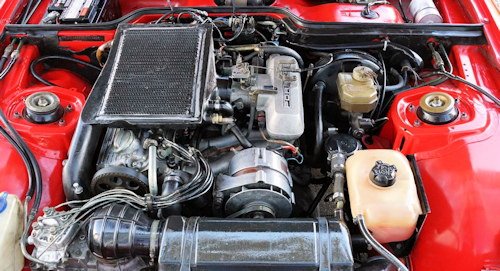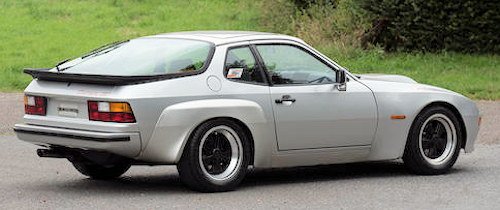Porsche 924 Carrera GT
 |
|
|
Manufacturer |
Porsche AG |
|
Production |
1981 |
|
Class |
Sports car |
|
Body style |
2+2 coupé |
|
Layout |
FR layout |
|
Engine |
2.0 L water-cooled I4 |
|
Length |
924 4,200 mm (165.4 in) |
|
Width |
924 1,685 mm (66.3 in) |
|
Height |
924 1,270 mm (50.0 in) |
|
Curb weight |
924 1,080 kg (2,381 lb) |
The Porsche 924 Carrera GT type 937 is a sports car produced by Porsche AG of Germany from 1981
History
The Porsche 924 Carrera GT was only produced in a limited edition of 400 units in 1981. The vehicle could not be sold in the United States because it could not fulfil the country's stringent emissions rules. To meet homologation requirements, the six prototypes were combined to create a total of 406 Carrera GTs.
Porsche was able to convert the 924 Turbo into the race car they had envisioned, dubbed the 924 Carrera GT, by adding an intercooler, boosting compression to 8.5:1, and making other minor improvements. The automobile served as the foundation for the development of the racing car types Carrera GTS, GTP, and GTR, which were successful in early 1980s sports car world championship events, such as the 24-hour race of Le Mans.
After a successful sales run of both naturally aspirated and turbo models, in 1980 Porsche surprised everyone and release the 924 Carrera GT, making clear their intention to enter the 924 in competition.
The prototype of the Porsche 924 Carrera GT (factory code 937) was presented at the 1979 IAA in Frankfurt. It was supposed to underline the capabilities of the 924 and at the same time give an outlook on the body shape of the planned Porsche 944.
The body of the car had widened fenders made of glass fiber reinforced plastic (GRP) at the front and rear . While the front fenders were harmoniously integrated into the lines and already had the shape of the 944, the rear fenders were attached. The front apron, the side skirts and the air scoop on the bonnet were also made of GRP in order to keep the vehicle weight low at 1180 kg. The windshield was glued flush with the body.
The interior largely corresponded to that of the 924 Turbo and contained a three-spoke leather steering wheel, a leather gear knob and sports seats and door panels covered in black and red pinstripe fabric. Many extras were available as special equipment, such as B. an alarm system, a car radio, electric windows, electric mirror adjustment, air conditioning, etc. can be selected.

The 924 Turbo with its 2-liter four-cylinder engine served as the foundation for this sports car. The engine received lighter forged pistons, harder camshafts, and a reworked cylinder head with a compression ratio changed from 7.5: 1 to 8.5: 1 to improve performance. The KKK turbocharger's maximum boost pressure has been increased to 0.75 bar, and a new charge air cooler has been installed. A so-called Hartig ignition system was used to manage the engine, which enhanced performance while while keeping fuel consumption low at roughly 9.1 litres per 100 kilometres. The engine produced 154 kW (210 horsepower) at 6000 rpm in this form. The car reached a top speed of 240 km/h and took 6.9 seconds to accelerate from zero to 100 km/h.

A revised gearbox was installed to match the engine output, and a limited- slip differential could be added if required. To save weight, the Porsche developers resorted to motorsport and gave the car a new, lightweight exhaust system. The Carrera GT had forged 7J × 15 Fuchs rims and 215/60 VR 15 wide tires as standard . For a surcharge, larger wheels with the rim dimensions front 7J × 16 with 205/55-VR-16 tires and rear 8J × 16 with 225/50-VR-16 tires could be ordered instead. The brake system with internally ventilated disc brakes was taken over from the Porsche 911 Turbo 3.3 .
